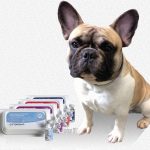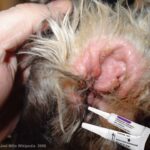Ear Infections in Your Dog or Cat – Otitis Externa
Ron Hines DVM PhD
 Surgery to cure the problem permanently?
Surgery to cure the problem permanently?



Other than when ear mites are involved, repeat ear infections are considerably more common in dogs than cats. The first few times they occur, these infections generally respond to ear drops and ointments that contain a corticosteroid and an antibiotic. Some of the newer products are a combination of florfenicol antibiotic, terbinafine, to control yeast, and mometasone furoate, a steroid to control inflammation. Some trade names for these products are Simplera™, Claro™and Simplera®. In 2022, a group of veterinarians associated similar products to the sudden onset of “Dry Eye” keratoconjunctivitis sicca. (read here) They suspected that ingredients in those products had affected the dog’s tear glands. But others have questioned those results.
What Will I See If My Pet Has An Ear Infection?
Most owners realize that their pet has a problem when it begins to shake its head and paw at its ear. It might seem to you that it began suddenly, but most of the ear problems brought to veterinarians have been brewing for quite some time. The exceptions are the ones where foreign bodies like small sticks, ticks, sand or some irritating chemical that entered the ear canal is the underlying problem.
All ear problems have an underlying cause that your veterinarian will try to determine. They don’t just suddenly pop up. Simply treating the ear for inflammation and infection with ointments, creams, antibiotics and topical corticosteroids almost guarantee that the problem will reoccur in the not too distant future.
What Are The Underlying Causes Ear Infections In Dogs And Cats?
Here are some of the common causes:
Ear Mites:
Ear mites are the most common cause of itchy and infected ears in puppies, kittens. The youngsters obtain these pin-head sized parasites from their parents as they nestle with them and nurse. During the first two months of life, the baby’s ears rarely appear dirty and there are often no signs that the mites are present.
However, by the third or fourth month, a brownish “coffee grounds” material begins to appear within the ear. These youngsters rarely have itchy ears yet. If these mites are discovered early, a few drops of permethrin or pyrethrin-containing oily liquid or even baby or mineral oil massaged down each ear canal will cure the problem. Ear mites breath through holes in their sides. Anything oily plugs these holes and kills them. Never place irritating liquids or water-based products in your pet’s ears. That includes anything with alcohol or bleach. Some get away with placing vinegar in their pet’s ears. I do not recommend doing that either.
If the problem is left untreated or improperly treated, the delicate linings of the ear canals can thicken and changes can occur that sometimes persist throughout your pet’s life. It is better to over-treated ear problems with gentle prescription medications when they are first discovered than to struggle to return a pet’s ear canal lining to its normal condition later. It is often impossible to accomplish once the damage has been done.
I suggest that after an approved product is used to kill the mites, a bland antibiotic and steroid-containing ointment should be used daily for several weeks. The medications do no good if they aren’t massaged down into the ear canal, where the infection actually is. Have a veterinary technician instruct you how to do that. Where you see the nasty goop is not where the problem is. That mess originated much farther down in the ear canal. Don’t place objects in your pet’s ear. You should just clean the outer portion of the ear flap and canal that you can see with a Q-tip while someone else restrains the pet.
Floppy Ears:
Dogs with floppy ears are naturally predisposed to ear problems because of the poor circulation of air within their ear canals. Humidity that builds up in the partially sealed canal space and the tendency for many floppy-eared dogs to have hair growing within their ear canals add to the problem. This is the reason spaniels, springers, Labradors and golden retrievers are so prone to ear problems. Any tendencies to allergies (atopy) those breeds may have (like paw licking and chewing) add to the likelihood of ear problems.
Wet ears after swimming – especially in swimming pools – can be an added risk.
Several liquid ear-cleaning antibacterial/antifungal products are on the market. Many contain boric and salicylic acids, eucalyptol, and propylene glycol. They often come in 8 or 16-ounce containers. About 4-10 drops massaged deep into the ear canals (of a 40-70 lb dog) after swimming or on a weekly basis often keeps those ear problems at bay in dogs prone to them. I prefer these products to those that contain antibiotics because the bacteria that will always live in your pet’s ear canals do not become antibiotic resistant to these over-the-counter products. Those over-the-counter products are great at prevention. But they may not be powerful enough to treat acute flare-ups. For those, you will need a product dispensed by your veterinarian. One of the dangers of not treating acute flare-ups vigorously are ear hematomas.
Allergies:
Dogs and cats with allergies often develop ear problems as well. That is because their ears itch as well as their skin. If you find a single flea on these pets – it is one flea too many. The cause of your pet’s itchiness needs to be found and treated, but I have no faith in the “blood-based allergy tests” some veterinarians still rely on. Effective treatments might include strict flea control, limiting the pet’s access to damp moldy areas, discontinuing brands of skin-care products, perfume, household cleaning agents or dietary management. When that is not sufficient, medications like Cytopoint® might be appropriate.
In stubborn cases, periodic ear medications containing steroids and antibiotics may be necessary. It is best to alter the formula (Brand) of ear ointments or ear drops every few months so that bacteria and yeast living in the ear canals of your pet do not become immune to the ingredients. You can use these products round-robin and eventually come back to the first one.
Conformation – How Your Pet Is Built:
Too much hair in the ears of certain breeds, particularly poodles, make them sensitive to ear problems. Plucking this hair from within the ears with your thumb and forefinger can help. So will trimming the hair on the underside of the ear flap and surrounding the ear. You can grasp this hair better if you dust it with a powder. Any residual inflammation of the ear is treated in the ways previously mentioned. Experienced groomers will generally do this well.
Immunosuppressive Virus:
Cats that are carriers of the feline immunodeficiency virus (FIV) or the feline leukemia virus (FLV) are prone to repeated ear and eye infections. Both these virus cripple the animal’s immune system defenses again infection. No similar virus I know of affects dogs.
Does Hypothyroidism Cause Ear Problems?
Most veterinarians did not believe that the two problems were related. The thought was that the two conditions could exist simultaneously in the same pet and that the added weight (obesity) of hypothyroid dogs – along with floppy ears – might predispose them to otitis. But hyperthyroidism was not thought to be a direct cause of otitis. That view is changing as articles begin to appear linking thyroid hormone with immune system defense. (read about that here, here & here) Hypothyroidism is exceedingly rare in cats; but if your dog develops repeated ear infections with no apparent cause, a T4 test might be in order.
What Are The Long-Term Complications Of Ear Infections?
Sometimes, despite proper treatment, ear problems continue and eventually result in a narrowed ear canal. In these cases, populations of antibiotic-resistant bacteria and yeast become established.
These ears can usually be managed for the pet’s entire life without surgery. I usually suggest that owners try to manage the problems with an ear medication that is antibiotic free. These products often rely on boric acid or acetic acid to kill the bacteria and yeast. Bacteria and yeast cannot become immune to these products like they do to antibiotic drops or ointments. Sometimes, drops that just contain steroids are best. If the ear canal is not too damaged, the steroids hardly pass into the pet’s body and can be used indefinitely. The only drawback is that they are generally sold at a high price in very small bottles. Sometimes, a puff of boric acid powder in each ear is all that is required. Many pet owners make their own mixtures of acetic acid (vinegar) and rubbing alcohol. These products can burn the ear canal lining and cause your pet pain if they are used wrong, too strong or too frequently. I do not suggest them.
Is Surgery An Option?
Yes, and sometimes it is the best option.
In some cases, pets won’t cooperate with long term preventative treatment. In others, the infection just cannot be controlled or reoccurs too frequently. In some cases, the infection spreads to the inner ear causing balance problems. In other cases, the problem is just too painful for your pet. In these cases, ear infections can be cured with surgery. There are two forms of surgery. In the first, the passage of the ear canal is re-directed downwards (otoplasty) to solve the problem by allowing the ear to drain naturally. If the eardrum has already been lost and infection has spread to the middle or inner ears, total ablation (closure) of the ear is preferable. It is also the best solution when super-resistant bacteria take over the canal. In addition, please see this article on corrective ear surgery. After the surgery, these pets usually go on to lead pain-free happy lives, even though their hearing is diminished.
Is There A Newer Surgery Technique To Deal With Chronic Otitis?
Yes
Until recently, veterinarians relied on electrocautery units to perform surgery in areas where there was abundant blood supply, such as your dog’s ear. Electrocautery was quite successful in sealing bleeding blood vessels, but it caused some damage to adjoining tissue and also some swelling that makes the pet’s ear canal even narrower. C02 lasers have been used in human medicine for many years. Initially, they were primarily used by plastic surgeons to resurface facial skin, and perform other delicate cosmetic surgery. But the price of these lasers put them beyond the budgets of most veterinarians. C02 lasers utilize certain waves of light to vaporize tissue more precisely than electrocautery that utilizes heat generated by an electric arc. The older time cauteries were not much more than medical soldering irons.
CO2 lasers, besides vaporizing unwanted tissue, seal off small blood vessels, preventing excessive hemorrhage and remove the need for your veterinarian to tie off the many small blood vessels of the ear canal one by one. I attended a seminar at which a Houston, TX veterinarian reported that he and his colleagues had managed to avoid ear ablation, a procedure which eliminates ear pain, but minimizes or eliminates hearing, using their C02 laser. A procedure referred to as “resculpturing” the ear. He did mention that several laser surgeries might be required. He also said that the end results were not always successful, but if they were not, one could always perform an ear ablation later. What was also mentioned was that many dogs in which this procedure was not successful were found to have middle ear infection that were not recognized earlier. The number mentioned was 20%. Another thing mentioned was that the majority of dogs that develop ear problems have atopic dermatitis.
You are on the Vetspace animal health website
Visiting the products that you see displayed on this website help pay the cost of keeping these articles on the Internet.




